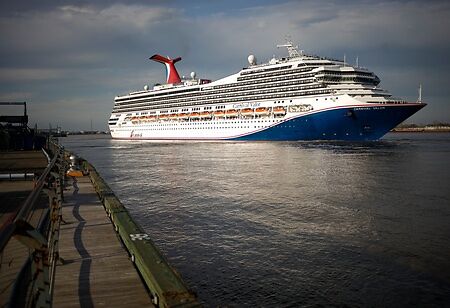
Cruising Till We Stop Bruising the Environment


One week trip on a cruise ship could dump 200 litres of waste, according to Stand.earth and West Coast Environmental Law (WCEL). Take the same for a year, cruise ships could discharge over 31 billion litres, about 8.5 US gallons of waste off the west coast of Canada from Alaska.
The Bigger they Are, the Larger their Environmental Impact
Large amounts of toxic sewage from toilets, greywater from sinks, showers, and laundries, and bilge water—the oily liquid that collects at a ship's bottom—all contribute to pollution on cruise ships. So-called scrubbers, which are equipment installed to remove exhaust gases like sulphur oxide and nitrogen oxide, as well as particulates, from the heavy bunker oil used as marine fuel, were by far the biggest source of pollution mentioned in the WWF report. The scrubbers produce wastewater that is acidic and chemically complex.
With the size they come and number of tourists they board, cruise ships polluting the environment would be an understatement. More precisely, they are a catastrophe to the entire marine life of an ocean and a huge contributor to carbon emissions. As guests ferry through the tides in merry, little do they know, they are leaving behind a trail of polluted waste poisoning the ocean. Everything that cruise ships come through, end up affecting the air, water, fragile habitats, coastal communities, and wildlife.
The cruise industry was one of the fastest-growing travel segments prior to the COVID-19 pandemic, with passenger numbers increasing consistently year over year. Cruise ships are a minor portion of the entire maritime sector, yet they have a significant impact.
Cruise ships are not only affecting the environment, but human beings who reside near ports are victims to ailments from the exposure of toxic waste dumped by cruise ships.
There are certain measures being implemented to reduce the impact on the environment, as well as, to allow cruise ships to dispose of waste.
Measures Eradicate Cruise Ship Wastage
In the Strait of Juan de Fuca and Puget Sound in Washington, close to the Canadian border, more than 6,000 sq km (2,300 sq miles) of ocean habitat are currently designated as a no-discharge zone and are therefore protected. In Alaska, cruise ships must request and obtain authorization before discharging sewage and greywater.
Under vessel pollution restrictions, untreated sewage from cruise liners may be discharged in Canadian waters outside a 12-nautical-mile boundary; nonetheless, this area frequently encroaches upon crucial habitats. Meanwhile, treated sewage, which includes bathroom waste and laundry and sink greywater, can be dumped three nautical miles from the coast.
An effort is being made to tighten pollution regulations. The federal government agency Transport Canada announced new restrictions in April, just before the start of the 2019 cruise ship season, to restrict the discharge of greywater and sewage from cruise ships operating in Canadian waters.
Despite being applauded, Bissonnette claims that the action is insufficient and points out that scrubbers are exempt from the voluntary measures.
Diverse toxic compounds represent a serious threat to aquatic wildlife, their habitats, and the food webs on which they depend when dumped into the ocean, including fragile populations of sea otters and orcas that dwell off the coast of British Columbia.
According to a study by the International Council on Clean Transportation, 10 percent of scrubber washwater discharged from ships off the coast of British Columbia occurred near orcas' vital habitats.
The innovative stabilisers on Ponant's new ship eliminate the need for it to use heavy anchors that could harm the seafloor. New hulls are made to move through water with minimal resistance, increasing fuel efficiency.
LNG (Liquified natural gas) is being heavily invested in by the Costa Group, a division of Carnival Corporation with Italian headquarters. Costa presently has four LNG-powered ships in its fleet; the first two joined in 2019 and the last two joined in 2018.
Additionally, it is recycling onboard food waste into fertilizer and getting ready to test out rechargeable batteries.
The corporation claims that the cruise workers themselves are a driving element behind its green development.
Additionally being developed as heavy fuel oil substitutes are biodiesel, methanol, ammonia, and hydrogen. Before widespread use, however, there are engineering, supply, and regulatory challenges that must be overcome.
Wartsila, a Finnish firm with a workshop in Genoa, develops and offers marine technology, with a particular emphasis on novel fuels. Methanol, according to Wartsila, is a leader in the transition to a green economy since it complies with environmental rules, has a reliable supply, and is also reasonably simple to retrofit into existing ships.
The quest of sustainability trickles down to those developing the next generation of cruise ships, who are likewise under pressure to innovate in a way that is as environmentally friendly as possible.
Three enormous warships are presently taking shape at the shipyard run by Fincantieri in Genoa, which has a workforce of about 5,000 people. One of the vessels is scheduled to be completed next month.
The decision by those in the cruise industry to release more pollutants has been widely condemned. The dumping of sewage and other such pollutants into the ocean has only exasperated environmental groups and governments responsible for cleaning it up. A variety of new technologies, including onboard incinerators, recycling initiatives, and less-polluting fuel sources like LNG, are available to reduce the garbage generated by cruise ships. However, the cruise and shipping industries are likely to continue avoiding many of the potential remedies in the absence of uniform standards and tightly enforced international regulations.